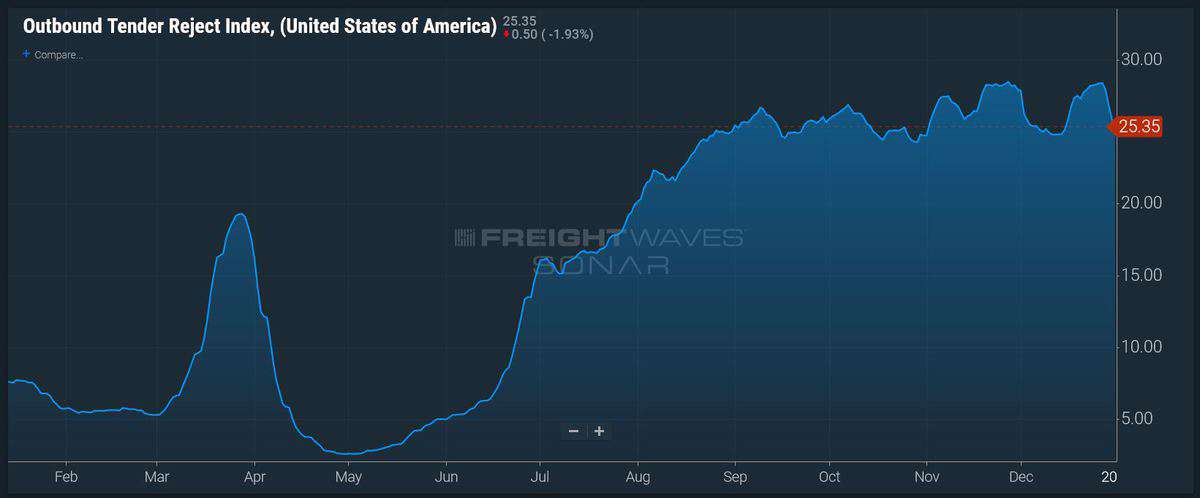Brokerage margins for volumes that 3PLs handled in the fourth quarter may have been the highest in years when measured in dollars, but the gross margin for those shipments was well below the prior quarter and the corresponding quarter a year ago.
The quarterly report of the Transportation Intermediates Association showed a gross margin for truckload of 11.4% for the quarter on an average invoice per load of $1,997. In a chart released as part of its quarterly report, the TIA data shows that the average invoice per load was easily the highest of the prior eight quarters, with the other quarters ranging from $1,572 in the disastrous second quarter of 2020 to $1,777 in the first quarter of 2019. It was up 14.1% from the fourth quarter of 2019.
But the gross margin in the quarter was the lowest among those eight quarters. The highest number in that period was in that first quarter of 2019, when it was 17.2%. The second lowest among the eight quarters was the 12.4% in the third quarter of 2020, meaning the fourth-quarter gross margin was a full 100 bps less than the prior three months.
The low margin of the three months — down 380 basis points from the fourth quarter of 2019 — is particularly striking when other year-on-year comparisons are made. In the fourth quarter of 2020, total truckload shipments handled by truckload carriers were up 9.4% from the year-earlier period. The invoice/load was up 21.9% and the total revenue was 27.7%. Yet margin took a significant slide, according to the TIA data.
“The significant reduction in broker margin percent presented in this report is a normal result of rapidly increasing freight prices, not a sign of broker weakness,” Noel Perry, the TIA’s chief economist, said in comments in the organization’s report. “In the same way, a gain in broker margins when freight prices fall is a normal market phenomenon, not a sign of broker leverage.”

What’s notable about the drop in truckload margin is that it was large companies that took the hit. Brokerages with more than $100 million in annual revenue saw their margins drop 110 bps compared to the third quarter, down to 11%. Companies with revenue of $16 million to $100 million saw a 50 bps decline in margin to 12.6% from 13.1%. Meanwhile, smaller companies did well, with a margin of 17.3%, up from 16.7%.
But the data makes clear it is the larger companies driving the market. Total loads for the 3PLs with revenue of more than $100 million totaled 947,641, down from 990,940 in the third quarter. Midsized 3PLs had a 2.4% increase, but their total loads were a fraction of the bigger companies, coming in at 110,870 loads. The smallest companies posted an 11.3% increase in loads, but that just takes it up to 10,134 loads.
The reality that it is truckload that is the core business of 3PLs is clear in the volume numbers for LTL business in the TIA report. Total LTL loads brokered by 3PLs was 129,112 in the fourth quarter, up from 121,774 in the third quarter. That’s just 12% of the amount of truckload business.
But for the LTL business that was done, it was more profitable than the truckload business. The LTL fourth-quarter business was also more profitable than the third-quarter business, counter to the trend that truckload saw.
LTL gross margins were 21% in the quarter, up from 17.6% in the third quarter. Another notable number from the data: The midsized 3PLs, with revenue of $16 million to $100 million, did more LTL business than the larger companies. Total LTL loads for the midsized 3PLs were 66,825 in the quarter, while the companies with revenue in excess of $100 million did 59,158 loads.
Intermodal shipments handled by 3PLs were virtually unchanged at 292,868 loads in the fourth quarter. The margin of 11.5% was slightly better than the 11.1% margin in the third quarter. But the invoice per load was up significantly over the third quarter, rising to $2,294 from $2,017.
What is striking is the year-on-year comparison. Total shipments were up 6.2% from the fourth quarter of 2019, while the gross margin climbed to 11.5% from 8.2%. The invoice size was up 5.4%.
A full copy of the report can be obtained here.
More articles by John Kingston
TIA: Q2 broker margins up over first quarter, down from 2019
New TIA chief Reinke stepping right into the fire
TIA: market conditions that created broker transparency rule no longer exist







